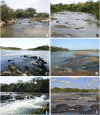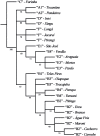River-specific macrogenomic diversity in Simulium guianense s. l. (Diptera: Simuliidae), a complex of tropical American vectors associated with human onchocerciasis
- PMID: 28727841
- PMCID: PMC5519218
- DOI: 10.1371/journal.pone.0181679
River-specific macrogenomic diversity in Simulium guianense s. l. (Diptera: Simuliidae), a complex of tropical American vectors associated with human onchocerciasis
Abstract
Simulium guianense Wise is a Latin American vector complex of black flies associated with transmission of the causal agent of human onchocerciasis (river blindness). An analysis of the chromosomal banding patterns of 607 larvae of S. guianense s. l. revealed a high level of variation involving 83 macrogenomic rearrangements across 25 populations in Brazil, French Guiana, and Venezuela. The 25 populations were assigned to 13 cytoforms (A1, A2, B1-B4, C, D, E1-E4, and F), some of which are probably valid species. Based on geographical proximity, a member of the B group of cytoforms probably represents the name-bearing type specimen of S. guianense and the primary vector in the last-remaining onchocerciasis foci in the Western Hemisphere. Cytoform B3 in Amapá State is implicated as an anthropophilic simuliid in an area currently and historically free of onchocerciasis. Distributions of cytoforms are associated with geography, elevation, and drainage basin, and are largely congruent with ecoregions. Despite extraordinarily large larval populations of S. guianense s. l. in big rivers and consequent production of female flies for dispersal, the cytoforms maintain their chromosomal distinction within individual rivers, suggesting a high degree of fidelity to the specialized breeding habitats-rocky shoals-of the natal rivers.
Conflict of interest statement
Figures

















References
-
- Procunier WS (1989) Cytological approaches to simuliid biosystematics in relation to the epidemiology and control of human onchocerciasis. Genome 32: 559–569. doi: 10.1139/g89-483 - DOI - PubMed
-
- Adler PH (2017) Biodiversity of biting flies: implications for humanity In: Foottit RG, Adler PH (eds.), Insect biodiversity: science and society. Volume 1, 2nd edition Chichester: John Wiley & Sons, pp. 713–745.
-
- Pramual P, Wongpakam K, Adler PH (2011) Cryptic biodiversity and phylogenetic relationships revealed by DNA barcoding of Oriental black flies in the subgenus Gomphostilbia (Diptera: Simuliidae). Genome 54: 1–9. doi: 10.1139/G10-100 - DOI - PubMed
-
- Hernández-Triana LM, Chaverri LG, Rodríguez-Pérez MA, Prosser SWJ, Hebert PDN, Gregory TR, et al. (2015) DNA barcoding of Neotropical black flies (Diptera: Simuliidae): species identification and discovery of cryptic diversity in Mesoamerica. Zootaxa 3936: 93–114. doi: 10.11646/zootaxa.3936.1.5 - DOI - PubMed
-
- Post RJ, Mustapha M, Krueger A (2007) Taxonomy and inventory of the cytospecies and cytotypes of the Simulium damnosum complex (Diptera: Simuliidae) in relation to onchocerciasis. Trop Med Internat Health 12: 1342–1353. doi: 10.1111/j.1365-3156.2007.01921.x - DOI - PubMed
MeSH terms
LinkOut - more resources
Full Text Sources
Other Literature Sources
Molecular Biology Databases

